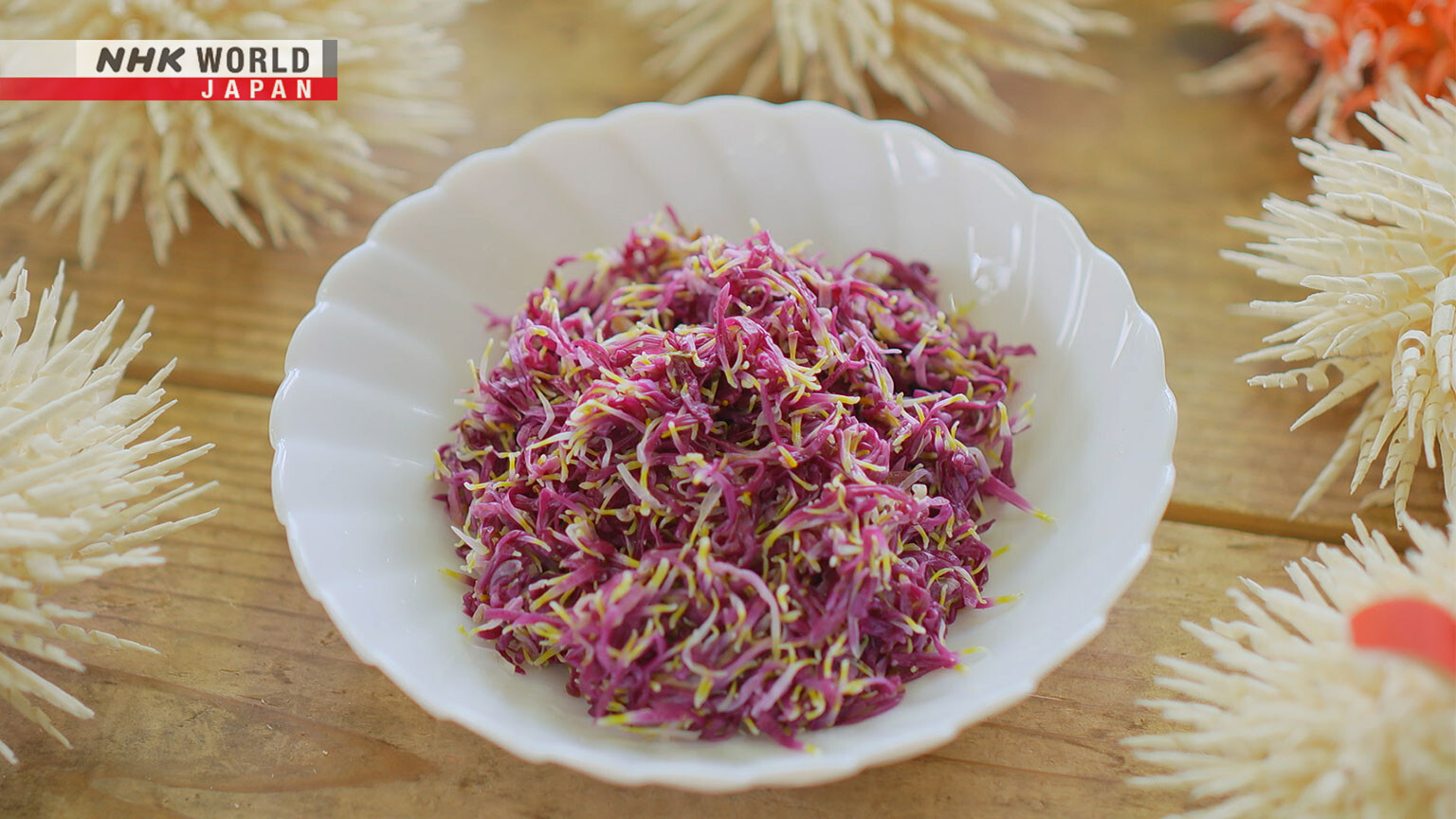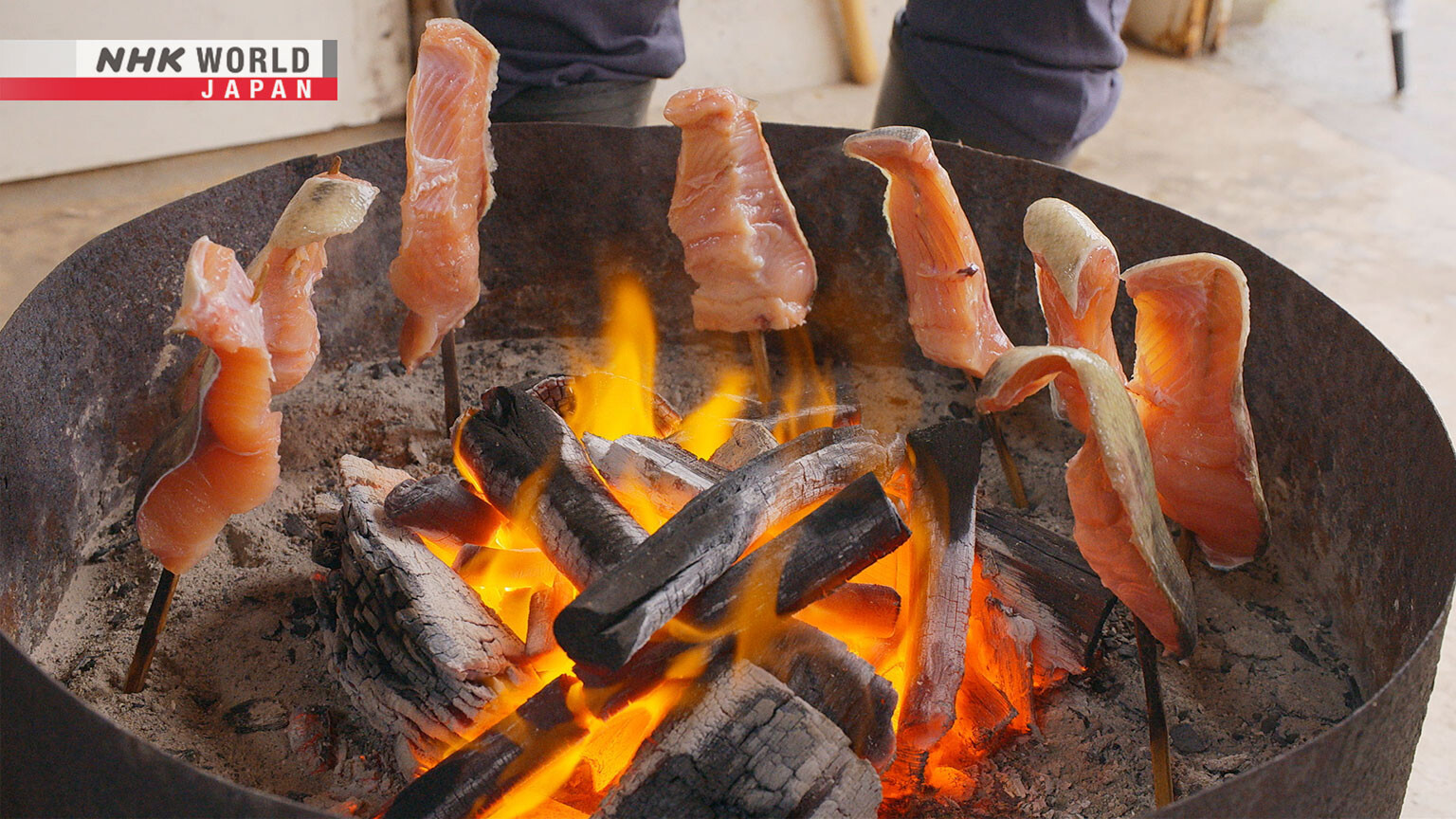Yamagata - Seeking the Flavors of Autumn
Yamagata Prefecture is famous for its food, some unique to late autumn and certain localities. Our gourmet cyclist explores the regional cuisine, from edible chrysanthemums to turnips and salmon.



Transcript
The best way to discover little-known sights and make even familiar places feel brand new, is to go exploring by bicycle.
This time, we'll be riding through Yamagata.
From a spectacular coast to beautiful rivers and high forested mountains, Yamagata has every kind of scenery.
At the end of autumn, we're seeing the first snows of winter.
This is a season when people traditionally busy themselves with creative activities.
It's also the best time of year to enjoy Yamagata's famously good food.
So good!
A place where nature can be harsh, but also generous with her bounty.
Come with us now, on a 425-kilometer ride through Yamagata.
Yonezawa City is in the south of Yamagata.
We start our trip from this shrine, dedicated to a historic local warlord.
Our cyclist is Bobby Judo, from Florida in the USA.
Most of Bobby's work in media revolves around food and cooking.
It's a super brisk morning.
Look at the mist rising off the water.
Right in the end of autumn.
The Mogami River runs through Yamagata from south to north, watering much of its fertile farmland.
The rice paddies here are finished for the year.
There's some kind of big statue up here on the right. What is that?
Oh, it's some kind of bird statue?
They've got the bird object displayed on the sign.
The birds Bobby saw are advertising a local craft.
Hello! Wow, look at this!
Ah, this is the one that we saw just over there.
This is the same design, right?
Incredible! This is really intricate.
If you look at it up close, you can see these wings and the feathers are all carved individually one by one.
- What is this?
- It's a hawk. In the local dialect, we call it "otakapoppo."
For about three hundred years, these birds have been made as toys in this district of Yonezawa.
We make them from early fall to winter. As you can see, I'm carving some right now.
- What are they?
- These are kezuribana, or whittled flowers.
- They're flowers?
- Yes, whittled flowers.
- Just made by whittling?
- That's right.
Some say that this technique for whittling wooden flowers has been in use for over 1,000 years.
Toda Kentaro is the seventh generation of his family to practice this craft.
Yonezawa has always been a very snowy area. The snow means we can't get flowers in winter.
But in this season we need to offer them at shrines and temples, and to our ancestors at home.
So people started making flowers from wood.
Now I just break it off, and form this part into the flower pistil.
And suddenly, a beautiful flower.
Chrysanthemums are prized in Yamagata for another reason too.
These are real chrysanthemums. I'll cook them with a little vinegar.
- Wait a minute! You eat them?
- That's right. These are for food, not decoration.
Really?
In the old days, when the rice harvest failed, people in Yonezawa survived by eating chrysanthemums and wild plants.
- Never tried these?
- Never.
It's really crunchy.
A bit like spinach.
And then the scent of the flowers fills your mouth. This is good.
I've been eating this since I was little.
- It's the taste of autumn?
- That's right.
Chrysanthemum season in Yonezawa.
Today, Bobby is headed for the mountainous northwest of Yamagata.
We've got our first little flurries of snow.
Woah, feel that wind.
That's getting close to hail.
It is cold.
We made our way well into the mountains.
It looks like there's a bunch of rocks out in the field over here.
Are those rocks?
Oh no, they're tree stumps.
Tree stumps burned black.
There was a fire here.
It's a whole hill covered in these burned stumps, these blackened stumps.
There's another big clump of those burned stumps up there.
You can see there's a person up there working or doing something.
Hello!
Sorry to interrupt you at work. Can I ask you something?
- Sure.
- Thank you!
As I cycled past I saw all these blackened stumps and wondered what they mean.
It's called yakihata - burning off the trees to plant crops.
After we cut down the cedar trees, we burn off what's left. That gives us a field for growing turnips.
This cyclical farming method is an effective way to utilize the land after forests have been felled for lumber.
The fire drives away pests, and the ashes fertilize the soil.
I think people started doing it because there's hardly any flat land in this area.
Burning the hillsides allows us to farm them.
Igarashi Shoichi, born and raised in these mountains, is both farmer and forester.
Turnip season lasts until the snows come. They grow sweeter and denser under snow.
Igarashi invites Bobby to his home.
Turnips from Igarashi's field, pickled with salt and sweet vinegar.
This is delicious.
And I like the crunchy texture.
- I need three.
- Use as many as you like.
Bobby has decided to try a new way of cooking turnips.
I thought I'd roast them in foil with butter.
He slices the turnips, inserts pats of butter, then seasons with salt, pepper and rosemary.
I think they'll cook through quickly.
Nice smell. And they look good too.
A drizzle of soy sauce and they're ready to eat.
Very soft!
Piping hot, right?
- This isn't just good, it's amazing.
- Right?
Roasted turnips from a burned field.
Haha. Twice roasted.
A taste you can only enjoy in Yamagata's mountains in autumn.
This is where the mighty Mogami River flows into the sea.
Today, Bobby will follow it upstream.
It's gotten so big, you can't really tell it from the ocean.
Bobby has left the Mogami to explore one of its tributaries.
Wow. You get down low, right up on it.
Absolutely gorgeous this time of year.
You get this silver-white of the susuki.
The yellows and reds of the trees.
Bobby will meet a man who loved this river so much he moved across Japan to live here.
Hello there!
I'm Bobby. Pleased to meet you.
Matsunami Mitsuo originally lived near Tokyo.
He studied fisheries science at university, and now works as a coordinator of fishing events in Yamagata.
Let's see what we can find. They'll be near that current over there.
- There! Did you see it?
- It's running away.
- I can just see a white tail.
- Yes, that's it.
Right up through here. Right up close to the bank.
They've found a salmon.
The name of this river, the Sakegawa, means "Salmon River."
Every year at this time, these fish swim up here to spawn.
These fish swim across an ocean to come back to their river. It's amazing.
Each November, special traps called urai are used to catch the salmon.
To help increase the number of salmon, they take the eggs,
hatch them and grow the fry until they are ready to be released.
Is this the place?
Why do so many salmon come to this particular river?
Matsunami has brought Bobby to this hilltop to explain.
Seeing this view made me decide to move here. It was exactly this time of year, too.
The trees are turning red now. These are just low mountains, but we get brilliant autumn foliage.
These forests are broadleaf trees, mainly beech.
Such forests store water, and so it accumulates more nutrients.
Streams carry these nutrients into the river, which attracts salmon here to spawn.
The salmon repay the forest by helping its growth.
There's a saying: "salmon make forests."
At sea, salmon store nutrients in their bodies. They return to the river, spawn, then die.
River insects eat the dead salmon, and small fish eat the insects.
Animals like bears eat the fish, and so the nutrients return to the forest.
It's a cycle. Forests feed nutrients to the river, making it a good place for young fish to grow.
That brings salmon to spawn here, and when they die, their bodies feed nutrients to the forest.
Rivers, forests, salmon - the cycle of nature.
Just an incredible landscape.
We've still got these vibrant green rice paddies, the fall colors in the mountains.
Blue sky, white clouds.
A perfect scenery.
The next day, Matsunami takes Bobby to taste the local way of cooking salmon.
Keen chefs, the Maruyamas work to promote the cuisine of this area.
- Now that's a fine salmon.
- Just caught this morning.
You can eat every part of a salmon.
- Every part?
- Yes. Nothing gets thrown away.
You'll be used to seeing salmon fillets.
They'll grill the salmon over charcoal.
Steam is already coming off the flesh.
Is there any difference between fish caught in the river and fish caught at sea?
Absolutely. Sea-caught salmon are very fatty, and great as sashimi, so they fetch a high price.
Salmon from the river are like marathon runners, with hardly any fat.
They don't eat or drink in the 60km swim upstream.
Today we call this a low-fat, high-protein food.
The salmon is glazed with a mixture of miso, sugar and sake.
It's got well-sauced now and crisping up really, really nicely.
And the miso is so full of umami flavor.
This one's for you!
- How do you like the miso?
- Amazing!
This fish was born here, swam tens of thousands of kilometers to Alaska and back.
It grew up, then returned to this river. I always feel a sense of gratitude as I eat.
This might have been the best salmon Bobby's ever tasted.
We're finally on the last leg of the trip.
Bobby will soon start climbing towards a mountain pass where he can look back over the road he's traveled.
A misty grey at the end of autumn.
Look at the visibility up ahead.
It's like a wall of fog. Like riding into a cloud.
This is it. This is our spot.
Here we are.
It's like we're standing in the clouds.
It's so quiet.
Far below, the river is shrouded in mist.
That was a great trip.
I've never traveled in these conditions before.
And I wanted to enjoy the food. I wanted to eat my way through Yamagata and I got to.
But I think it was the perfect season to see how the people here have developed this culture of taking whatever they can get.
The flexibility and the ingenuity that it takes to do that.
And that's what it takes to live in an environment
where the changing of the seasons is so drastic and the winter is so stark.
Bobby's trip just caught the last fading days of autumn.
Soon, Yamagata will be plunged into the icy cold of winter.